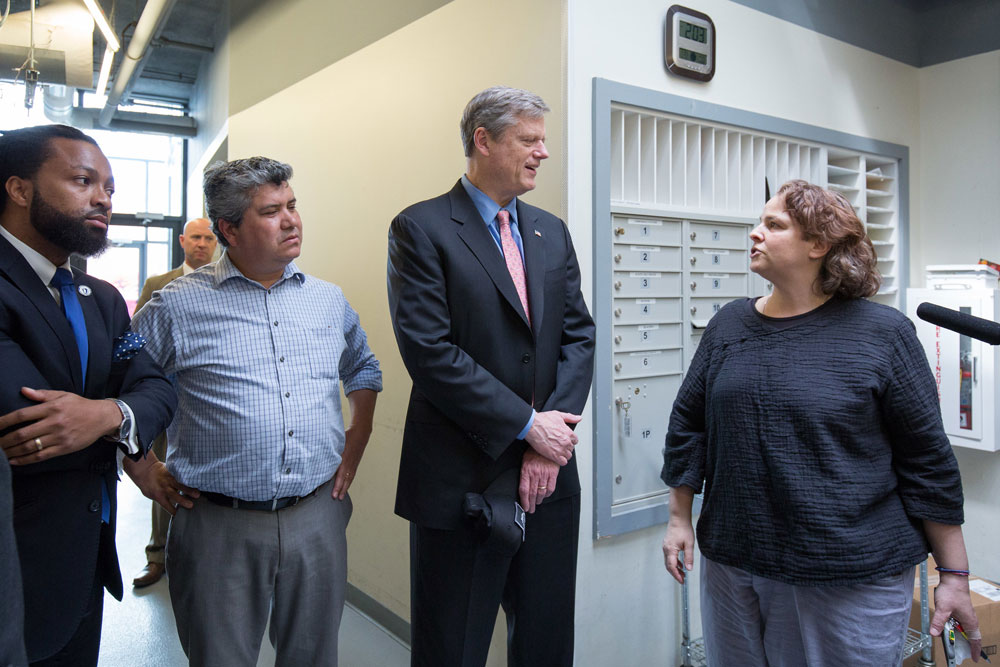
At CommonWealth Kitchen (CWK), a Boston-based nonprofit I have directed for the past five years, we believe food not only has the power to nourish and sustain us, but that it can catalyze a just, sustainable economy. When we launched in 2009, our premise seemed simple: Provide affordable access to fully equipped kitchens, and diverse entrepreneurs will be able to start and grow successful food companies, build assets and wealth, create jobs, improve food access, and build a more equitable food economy. Right? Not so fast.
In launching our shared kitchen, we quickly discovered that success for early-stage food companies—particularly those with diverse, largely undercapitalized business owners, many of whom are focused on culinary traditions and cuisines less familiar to the mass market—requires more than a great recipe and a cool logo. Business owners need to understand the intricacies of permitting, safe food handling, labeling, sourcing, packaging, distribution, margin calculations, managing multiple sales channels, customer acquisition, etc. The complexity is truly mind-numbing!
To meet our mission of building successful, diverse food businesses, our model had to address all of these needs. The shared kitchen was merely the starting point.
Bringing together human, social, and financial capital
Today, in addition to our shared kitchens, we offer wrap-around business and technical assistance to address the human, social and financial capital needs of our 55-plus member food companies, over 75 percent of which are owned by women, immigrants and/or people of color.
Our programming includes a 13-week food business startup class, with custom workshops on topics ranging from product development and food safety to marketing, labeling, access to capital, and sales strategy. We also offer mentoring, one-on-one advisory support, and an online resource library that includes financial templates for costing recipes and for calculating margins.
In addition, we provide coordinated access to retail, wholesale and food service markets. For food trucks and caterers, we connect them to office managers and event planners, and provide an opportunity to run their own takeout restaurant in our dedicated retail spot on a rotating basis.
For bakers and product companies, our market-access strategy includes forging connections with values-aligned distributors, specialty food retailers, large catering companies, grocery chains, and food service buyers. We also provide outsourced manufacturing to help member companies efficiently scale production, while aggregating multiple part-time jobs across many companies into full employment with CWK.
When not manufacturing for our members, we offer fee-for-service product development and small-batch processing for farms, restaurants, retailers, and anchor institutions. This small-batch processing capacity has the added benefit of helping us forge deep, trusting partnerships all along the supply chain, generate earned revenue to support our operations, create additional inner-city manufacturing jobs, and begin the process of building a values-aligned network of food-related businesses. For 2019, nearly 40 percent of our $2.75 million budget will come from earned income from kitchen operations.
The challenge of scaling
On average, nearly 70 percent of our member businesses sell packaged products or baked goods, like sauces, beverages, and vegan snacks. The typical process of scaling requires enormous cash outlays for product inventory, marketing, brand building, tastings, specials, and rebates that are standard in the industry (though no one tells you this!). Securing this kind of high-risk capital is difficult for any product company, and nearly impossible for the diverse companies we work with due to lack of networks, or personal credit, and collateral.
To have any hope of meeting our mission goal of helping these companies navigate a pathway to business success, we had to find an alternate path to sustainable sales.
What about anchor institutions?
Helping member companies scale required doing a market scan to understand where people eat outside the home. The first thing we saw was that Boston is home to 31 colleges and universities, which employ 35,000 people and enroll 136,000 students. The city is also home to 20 major hospitals. All told, the health care sector (of which hospitals, of course, are a major part) employs close to 145,000 people or 18.3 percent of the city’s workforce.
Pursuing an anchor institution procurement strategy to drive sales seemed like an obvious winning strategy. Right? Again, not so fast.
Anchor challenges
When we first started reaching out to college and hospital food service directors, the consistent response was an enthusiastic, “YES, we’d love to work with you!” However, navigating the seemingly endless procurement roadblocks has been an exercise in persistence, tenacity, frustration. and exhaustion.
The initial challenge was figuring out who to talk to, and then how to turn enthusiasm into actual action steps. To start with, each buyer we approached asked us to host a tasting event, provide sample products, pricing sheets, nutritional data and marketing materials, and host multiple meetings with a sea of sustainability officers, procurement managers, dining services directors, chefs, and third-party food service operators.
Sign up for our free newsletters
Subscribe to NPQ's newsletters to have our top stories delivered directly to your inbox.
By signing up, you agree to our privacy policy and terms of use, and to receive messages from NPQ and our partners.
If we got through all that, we then had to work through a cryptic process to clarify requirements for recipe reformulation, nutritional specifications, allergen statements, timeline, and process for integration into menu cycles, pricing, pack size, serving size, on-boarding with pre-approved distributors, insurance, food safety certifications, pricing, distributor markups, etc.
After three-plus years of working through this process, we’ve finally begun to develop a few signature accounts, with member products integrated into menus at Harvard University Dining Services and Boston Children’s Hospital. We’ve also completed one-time and short-term sales to Boston Public Schools, Boston College, Massachusetts Institute of Technology, and Brigham and Women’s Hospital. With continued focus, patience, and persistence, we are on track to have ongoing sales of member products in four to six institutional accounts within the next 24 months.
For our member businesses, being able to tell buyers, distributors, and potential investors that they’re selling to large buyers like Harvard University is a powerful story. Any single account is not enough to build a viable company, but ongoing sales across multiple institutional accounts can foster long-term business success. Still, it’s been a long road getting there.
Some hard-earned lessons
If you know one institutional buyer, you know one buyer.
It’s critical to understand each buyer’s motivation. For some, the focus is about sourcing more local ingredients. For others, they’re looking for unique products generally not available from traditional commodity food companies, and difficult to produce consistently on their own. The key to getting regular, consistent sales is being able to respond to the specific needs of the buyer, which means satisfying the needs of the chefs, procurement staff, sustainability staff, etc.
Integrate into their process.
It’s not enough to have a great product that fills a specific purchasing need. If the process required to purchase and deliver the product can’t be integrated into a buyer’s existing procurement and billing systems, the likelihood of getting more than a few onetime purchases is nil. It’s critical to map out the entire process as early as possible. This means becoming an approved vendor with pre-approved distributors, making sure products are integrated into ordering guides, meeting food safety requirements, and working directly with chefs to finalize product formulations, and getting products integrated into the regular menu cycle.
Price matters, but it matters less if you have a unique product to offer.
Despite their substantial budgets, institutional dining services have enormous price sensitivity. Often too, the product you propose is competing against existing established purchasing “programs” with distributors and suppliers, which create exclusive buying agreements for certain categories of products.
For example, in 2019 we worked with Sodexo on a pilot project to provide a line of “rescue foods” products for several Boston-area hospitals. The project involved sourcing surplus produce from local farms and processing it into products, like pesto, roasted butternut puree, and a vegetarian “meatball.” Initially, we had hoped to also integrate tomato-based products, like a local marinara or salsa. However, due to a pre-existing contract with a large multinational tomato product company, Sodexo was unable to purchase any tomato-based products.
Similarly, we worked with several of our farm partners to create a local apple sauce sourced from surplus Massachusetts apples. The idea sounded like a winner to Sodexo, but our price was more than double the cost of traditional applesauce, and not unique enough for them to justify the cost. By contrast, turning those same local apples into a frozen, ready-to-bake apple crisp kit was the perfect answer to Harvard dining’s need for local dessert options, and since there were no competitors, we were able to work through a price that makes sense for all involved.
Alignment of interests is key.
For over a year, we tried to break into the purchasing process of Sodexo, one of the largest third-party food service operators in the world. We thought a large buyer that handles multiple accounts would help us secure large and consistent sales volumes. Frustratingly, after a year of working through Sodexo’s complex menu planning and vendor on-boarding process, and also investing nearly $100,000 of our own resources into managing negotiations and securing various food safety certifications required, Sodexo has purchased less than $20,000 of product. In the end, their prior contractual commitments to large food companies, and focus on bottom line, kept local staff from being able to honor the purchase plans we had discussed for well over a year.
In retrospect, we now know that the only way this work with Sodexo could have succeeded was if national buyers had committed to it, which would require a major shift in their organizational culture and decision-making structure. In the end, this lengthy and expensive process was enormously destabilizing for our small non-profit.
Conversely, our work with independent buyers has been much more productive and collaborative. For example, our work with Harvard University Dining Services should lead to nearly $200,000 of sales for our nonprofit and three of our member companies for 2019–2020. The clear difference is that with Harvard, we are working directly with the decision-makers, and able to navigate the procurement process collaboratively. In contrast, working with Sodexo required working across numerous layers of very rigid and largely opaque procurement and approval processes, and, in the end, price mattered more than mission or impact.
Going forward, we plan to focus primarily on independent buyers. While the process of securing accounts one-by-one is much slower, at least we can reasonably count on consistent sales.
Conclusion
Working with diverse entrepreneurs to start and build successful food companies as a means to build assets and wealth, create jobs, and improve food access is an enormously complex endeavor—particularly when running up against the largely immovable forces of a centralized, consolidated food system, where a handful of players control the vast majority of it.
Building sales with anchor institutions is not a strategy for the faint of heart. However, with persistence—and a careful strategy that builds relationships with buyers one at a time—it can help build the road towards a food economy that prioritizes equity, opportunity, and resilience.










